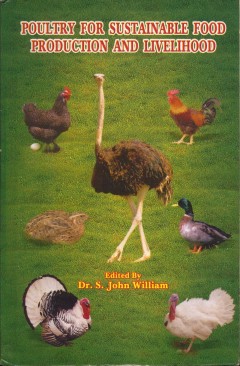Ditapis dengan
E-book Poultry Production and Agribusiness Training Manual for Small and Medi…
The materials in the manual are a blend of theory from expert knowledge, review of training manuals from other countries including Ethiopia, Uganda, India, Nigeria, review of manuals, and guides from trademarks of broilers, layers, and specially developed dual-purpose breeds of Sasso, Kuroiler and Boschverd. The Department of Animal Health and Livestock Development (DAHLD) developed livestock g…
- Edisi
- -
- ISBN/ISSN
- -
- Deskripsi Fisik
- 191 hlm
- Judul Seri
- -
- No. Panggil
- 636.5 GON p
E-book Poultry : Sub Sector Skills Plan
Chapter 1 of this report provides an overview of the agricultural sector, paying particular attention to the Poultry sub-sector in South Africa. The first section of this chapter looks at the scope of the Poultry sub-sector’s coverage. The second section describes the AgriSETA stakeholders and key role-players in the Poultry sub-sector. The third section looks at the economic performance of t…
- Edisi
- -
- ISBN/ISSN
- -
- Deskripsi Fisik
- 46 hlm
- Judul Seri
- -
- No. Panggil
- 636.5 AGR p
E-book Australian Animal Welfare Standards and Guidelines for Poultry
The development of Australian Animal Welfare Standards and Guidelines for Poultry is an important initiative of Australian governments to guide new, nationally consistent policies to enhance animal welfare arrangements in all Australian states and territories. The development process is supported and funded by all governments and the major poultry industries. The standards provide a basis for d…
- Edisi
- -
- ISBN/ISSN
- 9781760034412
- Deskripsi Fisik
- 65 hlm
- Judul Seri
- -
- No. Panggil
- 636.594 AUS a
E-book Organic Poultry Production
The manual was produced by the Research Institute of Organic Agriculture FiBL and developed for the Knowledge Centres for Organic Agriculture (KCOA) in Africa implemented by the Deutsche Gesellschaft für Internationale Zusammenarbeit (GIZ) on behalf of the Federal Ministry for Economic Cooperation and Development (BMZ) of Germany. All the information contained in this manual has been compiled …
- Edisi
- -
- ISBN/ISSN
- -
- Deskripsi Fisik
- 71 hlm
- Judul Seri
- -
- No. Panggil
- 636.5 FIB o
E-book Poultry Industry Manual
Broiler chickens are bred and raised for meat production. The broiler industry is the most advanced system of animal food production and the United States has the world’s largest broiler industry. In 2012, data released by the National Chicken Council indicates that the broiler industry provides over 1 million jobs, $47 billion in wages, $197 billion ineconomic activity, and $17.2 billion in …
- Edisi
- -
- ISBN/ISSN
- -
- Deskripsi Fisik
- 178 hlm
- Judul Seri
- -
- No. Panggil
- 636.5 FAD p
E-book Poultry Development Review
A recent survey of several countries found that 34 percent of the people surveyed in South Asia and 59 percent in SSA were suffering from severe energy deficiency (Smith and Wiseman, 2007). Both groups obtained 67 percent of their energy from staple foods (cereal grains, grain legumes, starchy roots and tubers) containing small quantities of only low-quality protein. Their average per capita eg…
- Edisi
- -
- ISBN/ISSN
- 9789251080672
- Deskripsi Fisik
- 127 hlm
- Judul Seri
- -
- No. Panggil
- 636.5 FAO p

Poultry for Sustainable Foor Production and Livelhood
- Edisi
- -
- ISBN/ISSN
- NA
- Deskripsi Fisik
- xi+377 hlm. 14x22cm
- Judul Seri
- -
- No. Panggil
- 636.5 WIL p
- Edisi
- -
- ISBN/ISSN
- NA
- Deskripsi Fisik
- xi+377 hlm. 14x22cm
- Judul Seri
- -
- No. Panggil
- 636.5 WIL p
 Karya Umum
Karya Umum  Filsafat
Filsafat  Agama
Agama  Ilmu-ilmu Sosial
Ilmu-ilmu Sosial  Bahasa
Bahasa  Ilmu-ilmu Murni
Ilmu-ilmu Murni  Ilmu-ilmu Terapan
Ilmu-ilmu Terapan  Kesenian, Hiburan, dan Olahraga
Kesenian, Hiburan, dan Olahraga  Kesusastraan
Kesusastraan  Geografi dan Sejarah
Geografi dan Sejarah